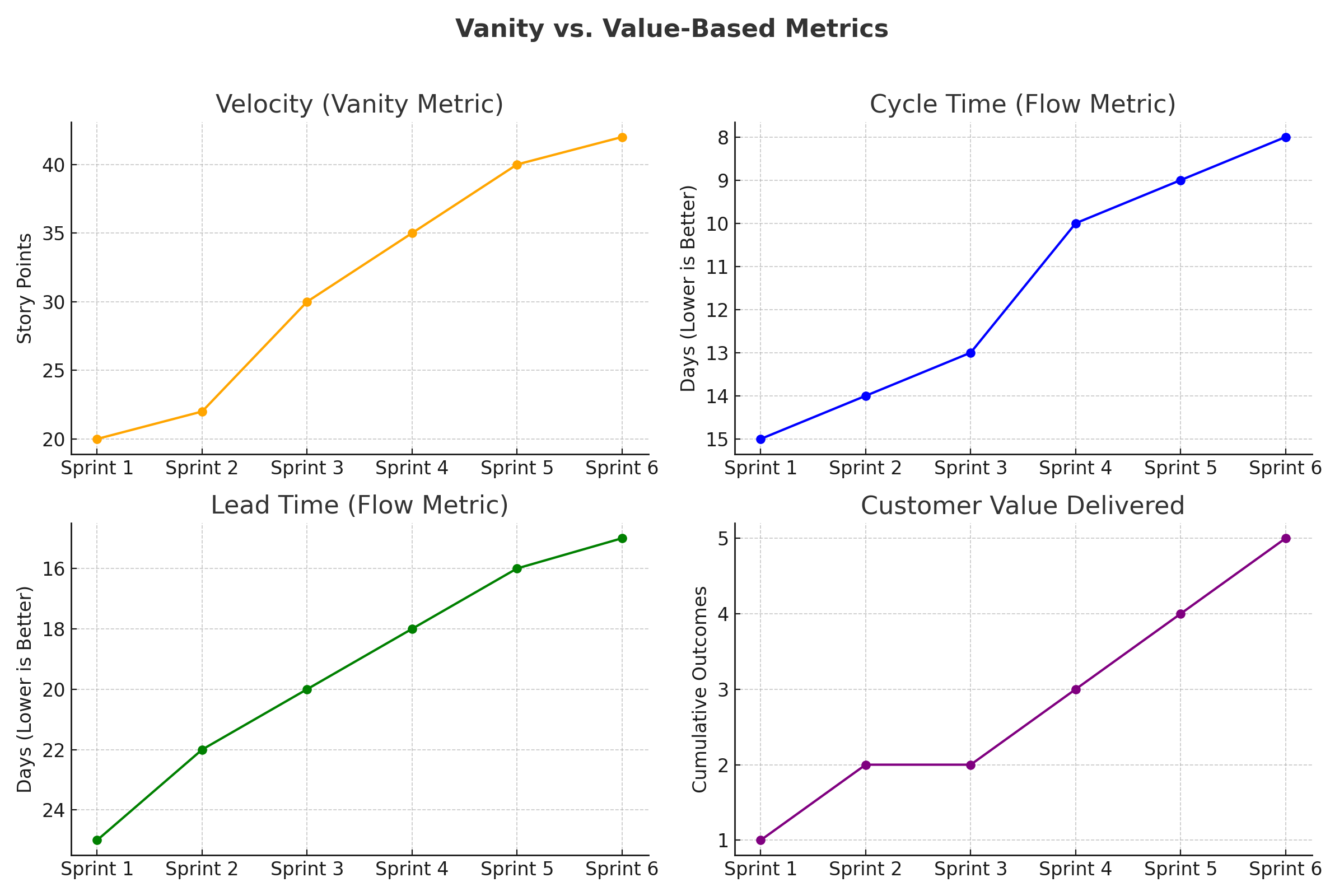
At the quarterly business review, the VP of Engineering proudly highlighted the team’s velocity chart in our monthly metrics review with senior leadership. The graph showed a steep climb: the team had doubled its velocity in just three months. “This,” he said, “is proof that Agile is working here.”
But inside the team room, developers had a different story. The velocity spike came not from delivering more value, but from splitting work into smaller and smaller stories. The board looked busier, the charts looked prettier, but customers weren’t getting features any faster. In fact, complaints were rising about incomplete flows and delays in integration. Morale dipped as leadership praised numbers that no one on the team believed reflected reality.
The turning point came when their Scrum Master stepped in. Instead of celebrating velocity, she reframed the conversation around cycle time, lead time, and predictability.
By tracking the time it took to move work from idea to done and measuring customer feedback alongside delivery, the team uncovered real bottlenecks in testing and deployment. Within a few sprints, they cut their cycle time by 40%, stabilized releases, and, most importantly, restored trust between leadership and the team. The numbers finally matched the outcomes.
Product sensed this all along by the way; we were celebrating the metrics, but they couldn’t quite figure out why our customer sentiment wasn’t matching our internal celebrations.
What.
Velocity is a tempting metric. It’s simple, visual, and gives the illusion of progress. But not all variation signals real improvement. When velocity increases without corresponding gains in value delivered, it’s noise, and mistaking noise for signal erodes trust.
Better measures exist. For instance, Scrum Masters can guide leaders toward:
- Cycle time: How long does it take to complete one work item once started?
- Lead time: How long from idea to delivery in the customer’s hands?
- Predictability: How often does the team meet its commitments?
- Value delivered: What outcomes are improving for the customer or business?
These metrics align with Agile’s principle of delivering working software frequently and focusing on business value, not busywork. There are many more, of course, but sometimes we have little direction to get started, so these typically can be a great starting point and are pretty easy to implement.
So What.
Why does this matter? Because misapplied metrics don’t just mislead, they actively damage culture. When leaders celebrate vanity metrics, teams lose faith in leadership (secretly rolling their eyes). When developers know velocity is being gamed but leadership insists it’s success, cynicism grows.
On the other hand, when teams measure flow, outcomes, and health, leaders get a more honest picture of "performance". Decisions improve. Trust is rebuilt. And most importantly, the focus shifts from “doing Agile” to actually being agile; responsive, outcome-focused, and value-driven.
Now What.
Scrum Masters can start small:
- Plot cycle time trends for the past few sprints and share them with leadership.
- Highlight lead time from idea to delivery to show where delays actually live.
- Pair metrics with customer outcomes. Are satisfaction scores improving? Are defect rates declining?
- Facilitate discussions about what these metrics reveal, not as performance scores, but as learning signals.

This isn’t about throwing velocity out completely (velocity is a great planning tool and internal team metric); it’s about putting it in its place; one signal among many, never the sole measure of success. Leaders need results; they have a difficult enough job and responsibility; let's help them do their jobs better as well!
Let's Do This!
Velocity can be gamed. Value cannot. Scrum Masters who help teams and leaders move beyond vanity metrics unlock more than better charts; they unlock better conversations, better trust, and better outcomes.
The goal isn’t to measure how fast the team is moving, but how effectively they are delivering real value. In the end, Agile isn’t about rituals or reports, it’s about results. And those results only show up when we measure what matters and keep improving.